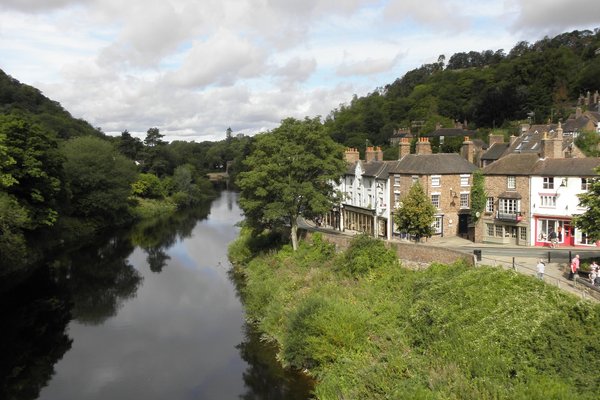United Kingdom
Ironbridge Gorge
Ironbridge Gorge was the innovative center for iron making during the First Industrial Revolution.
The Coalbrookdale blast furnace represents the breakthrough development of smelting iron using coke instead of charcoal in 1709. Subsequently, iron, tiles and porcelain were made here on an industrial scale. Iron Bridge was built as the first known metal bridge. Remains of the industrial era are spread out over 3.6 kilometers in the Severn Valley. They include mines, factories, warehouses, canals, railroads, housing and public buildings. The area was rich in raw materials, and the river made transport easy.
Community Perspective: The area, centered around a picturesque little town, is littered with small museums which add up in cost if you want to visit a number of them. Coalbrookedale Iron Museum, Blists Hill open-air museum and Coalport China Museum are recommended. Fortunately, the Bridge is still free to enter.
Site Info
Official Information
- Full Name
- Ironbridge Gorge (ID: 371)
- Country
- United Kingdom
- Status
-
Inscribed 1986
Site history
History of Ironbridge Gorge
- 1986: Inscribed
- Inscribed
- Type
- Cultural
- Criteria
- i
- ii
- iv
- vi
Links
- UNESCO
- whc.unesco.org
- Official
-
- ironbridge.org.uk — Ironbridge Gorge
- Related
-
- en.wikipedia.org — Wikipedia on the Iron Bridge
- ardmediathek.de — Schätze der Welt
All Links
UNESCO.org
- whc.unesco.org — whc.unesco.org/
Official Website
- ironbridge.org.uk — Ironbridge Gorge
Related Resources
- en.wikipedia.org — Wikipedia on the Iron Bridge
- ardmediathek.de — Schätze der Welt
News Article
- Oct. 17, 2025 bbc.com — National Trust to take over Industrial Revolution museums
- Jan. 8, 2019 shropshirelive.com — Iron Bridge officially reopens following £3.6m conservation project
- Dec. 25, 2017 shropshirestar.com — Snow damage will cost thousands in Ironbridge Gorge
- Feb. 26, 2015 dailystar.com.lb — Archaeologists discover secret room in ancient Sidon temple
- Nov. 26, 2014 bbc.com — Ironbridge lost cottages uncovered during works
- Oct. 11, 2013 dailymail.co.uk — Ironbridge Gorge is under 'extreme' threat from landslides
- Dec. 30, 2012 shropshirestar.com — Flooding hits Ironbridge
- Oct. 4, 2012 bbc.co.uk — Ironbridge Gorge gets £ 12m government grant
- Aug. 17, 2011 shropshirestar.com — Ironbridge was one of the most visited tourist attractions in England last year with more than 567,000 people paying
- May 26, 2011 shropshirestar.com — £ 80m bill to stop Ironbridge Gorge land slippage
- March 16, 2007 shropshirestar.co.uk — Developers will be prevented from building wind turbines in Shropshire's world famous Ironbridge Gorge under strict new planning restrictions.
Community Information
- Community Category
- Secular structure: Factories and industry
Travel Information
Free entrance
Wales hotspot
Recent Connections
-
Free entrance
The Iron Bridge at least is free -
Wales hotspot
70km / 2h by train and bus -
Northern England hotspot
Connections of Ironbridge Gorge
- Geography
- Trivia
-
-
Versions of Da Vinci's last supper
In Colebrookdale Museum of Iron there is an Iron version
-
- Ecology
-
-
Otters
a swiftly flowing river in which salmon, otter and kingfishers are thriving once again (sse link)See www.erih.net
-
- Architecture
-
-
Glazed tiles
Tile factory in Jackfield -
Iron Structures
Cast Iron
-
- World Heritage Process
-
-
Perfect Inscriptions
1986
-
- Human Activity
- Constructions
-
-
Obelisk
Coalbrookdale War Memorial, an obelisk but with a cross added to the topSee www.google.com
-
Canals
Shropshire Canal -
Notable Bridges
the world's first iron bridge (1779) -
Protective Shelters
Over the Old Furnace in Coalbrookdale -
Funiculars
Hay Inclined Plane ("It can be considered a specialised type of funicular railway")See en.wikipedia.org
-
Tunnels
Tar Tunnel: "Miners struck a gushing spring of natural bitumen, a black treacle-like substance, when digging the tunnel in 1787, probably in connection with the nearby coal mine workings. It was a great curiosity in the 18th century and bitumen still oozes from the wall today." (wiki) -
Railways
Early horse-drawn tramways, replaced by a private standard-gauge railway network in the 2nd half of the 19th century
-
- WHS on Other Lists
-
-
European Route of Industrial Heritage
-
Historic Civil Engineering Landmarks
See www.asce.org
-
ASM Historical Landmarks
The Iron Bridge, Telford (1984) -
Europa Nostra Award
The Iron Bridge, Shropshire (Conservation, 2020) -
European Museum of the Year Award
Ironbridge Gorge Museum Trust, Ironbridge (1977)
-
- Timeline
-
-
Built in the 18th century
The Coalbrookdale blast furnace perpetuates in situ the creative effort of Abraham Darby I who discovered coke iron in 1709. It is a masterpiece of man's creative genius in the same way as the Iron Bridge, which is the first known metal bridge. It was built in 1779 (AB ev)
-
- WHS Hotspots
-
-
Northern England hotspot
-
Wales hotspot
70km / 2h by train and bus
-
- Visiting conditions
-
-
Free entrance
The Iron Bridge at least is free
-
News
- bbc.com 10/17/2025
- National Trust to take over Indust…
- shropshirelive.com 01/08/2019
- Iron Bridge officially reopens fol…
- shropshirestar.com 12/25/2017
- Snow damage will cost thousands in…
Recent Visitors
Visitors of Ironbridge Gorge
- Adam Hancock
- Adrian
- Adrian Turtschi
- Alexander Lehmann
- Alex Goh
- alicemears
- A. Mehmet Haksever
- Andrew_Kerr
- Anna Wludarska
- Anne
- anthonybonbon
- Argo
- Atila Ege
- awestix
- basementonline
- BaziFettehenne
- BenReeve
- Bill Maurmann
- Birgitte Sørensen
- Brett Baumann
- butterflybird
- CampbellME
- Carrascu
- Caspar
- ChrisN
- Christian Wagner
- christof
- Christravelblog
- Claire Bradshaw
- ClaraHH
- Clyde
- Colossus
- Csaba Nováczky
- Damientournay
- Daniel Chazad
- Danny L
- Dan Pettigrew
- David Scott King
- Dimitar Krastev
- Dorejd
- Dr. Caligari
- edstar500
- Elaine McArdle
- Elf21
- Elis
- Elisabeth Fransisca Situmorang
- Elliot
- Els Slots
- emvcaest
- Erik Jelinek
- Eva Kisgyorgy
- Fan Yibo
- Farinelli
- Filip Murlak
- finsbury_jo
- forest80
- Frederik Dawson
- Gabbro
- Garry Jackson
- George Gdanski
- GeorgeIng61
- Gernot
- Glenn Nightingale
- Grzegorz Andruszkiewicz
- Harry Mitsidis
- Hubert
- Iain Jackson
- Ian Cade
- Ivan Rucek
- Jakob F.
- James Bowyer
- janem
- Janina Lehmann
- Jan Korpeg
- Jarek Pokrzywnicki
- Jay T
- Jeanne OGrady
- Jesse S 2010
- Jezza
- Joel on the Road
- Jonas Hagung
- Jonas Kremer
- Kevin Padley-Knight
- kutasp
- Lara Adler
- leckie118
- Loic Pedras
- Luboang
- lucyannesmith
- Luis Filipe Gaspar
- Luj3904
- Maciej Gil
- Martina Rúčková
- Matthewsharris
- MaYumin
- MH
- MichaelH
- Mikko
- Milan Jirasek
- Ming_9734
- MMM
- nan
- Neil McPaul
- Nihal Ege
- opperpco3
- PabloNorte
- Pat Martin
- Patrik
- Paul Schofield
- Peter Lööv
- pete_simms
- Petteri
- Philipp Peterer
- Piotr Wasil
- pressdm
- Ralf Regele
- Randi Thomsen
- rogerding
- Roger Ourset
- Roman Bruehwiler
- Rosemary
- Rudegirl
- Sabrina Liebehentschel
- Samy G
- Schnitzel
- SDMArado
- Sergio Arjona
- Shandos Cleaver
- sibariam
- Solivagant
- Squiffy
- Squire Sullen
- Ssong.x
- Stanislaw Warwas
- Stefan A. Michelfeit
- Sturuss
- Svein Elias
- Szucs Tamas
- Tamara Ratz
- Tango
- Taotao Chen
- Tarquinio_Superbo
- Tatiana Nikulnikova
- Tevity
- Thomas Buechler
- Thomas Harold Watson
- Thomas van der Walt
- TimPick
- Tinuszke
- Tom Flaten
- tony0001
- Truls Brekke
- Tsunami
- usagi1974
- ValiaVeweth
- Viaje al Patrimonio
- Vincent Cheung
- V&M
- WalGra
- Walter
- WestcountryWanderer
- WILLIAM RICH
- Wojciech Fedoruk
- Wo_ko
- Yongcheng Liu
- Zach
- zinar7
- Zoë Sheng
- Александар Стојиљковић
Community Reviews
Show full reviews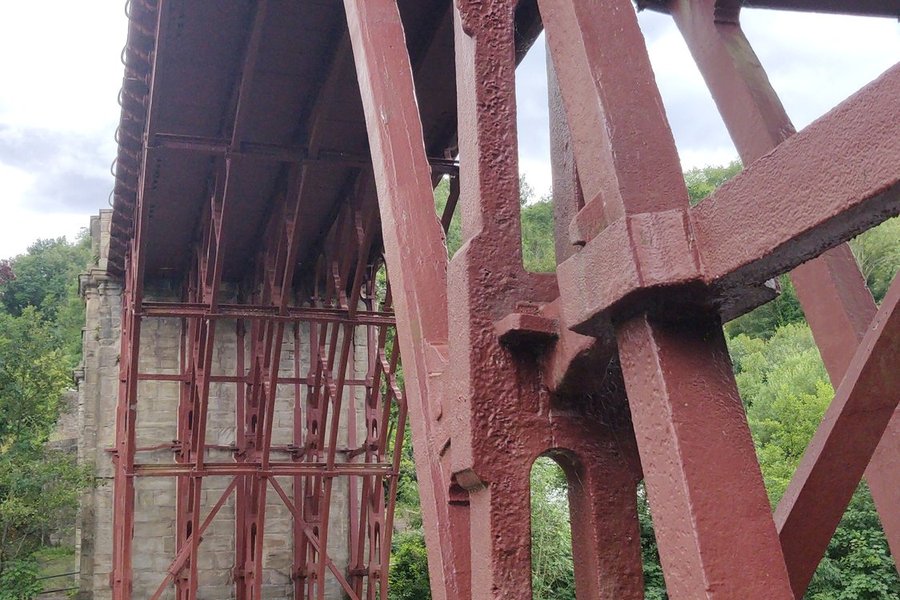
Certainly a major achievement by mankind, this bridge is important, but only impressive if you consider when it was built: Construction began in 1779, and the bridge opened on New Year's Day 1781.
There isn't much to see, but you can walk across and underneath it, making it easy to observe and take some shots of the bridge. There is a tourist information desk at one end of the bridge. There's a site museum, too, which was already closed when I got there. The bridge is said to be open until sun set.
Getting there
This can easily be reached by public transport from Birmingham and other places in the area. There are some buses going from other places near, but I got off at Telford train station and took the bus to Telford bus station. Direct buses depart from there. Make sure to check the return schedule as they don't run frequently in the evening.
Keep reading 0 comments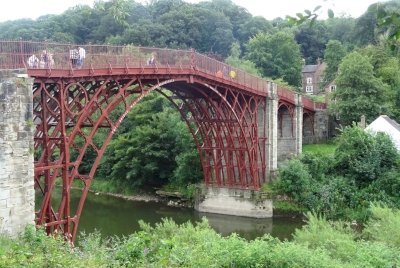
Swollen by the night’s rains, the River Severn flowed smoothly through the valley. Above it the delicate lattice-work arc of the bridge leapt like a salmon. Day-trippers crossed the span. The scene was reminiscent of that painted over 240 years earlier by William Williams – all that was missing was a rowboat of magnificently behatted ladies beneath us on the river. The entire scene was quaint, almost pastoral, with the river rolling below the tree-garlanded hills and the stonework of Ironbridge village’s church glowing in the late afternoon sun. Yet my thoughts turned to a different painting – Philip James de Loutherbourg’s Coalbrookdale by Night, where the heavens are lit up by the infernal flare of forge and furnace. And I was reminded that the Iron Bridge, graceful as it remains, was a product of intensive industrialisation that must have been utterly terrifying to many.
The Ironbridge Gorge World Heritage Site has a dual identity. The image everybody sees is the bridge itself, the world’s first to be constructed of iron. The bridge is in and of itself deserving of inscription – more so than, say, the Forth Bridge that followed 109 years later. And the village of Ironbridge remains exceptionally pretty, a lovely spot for a stroll and a bite to eat in a tea shop. But the bridge was essentially the shop window of the local ironmasters, principally Abraham Darby III. The bridge was needed to link the two sides of a river too shallow for …
Keep reading 0 comments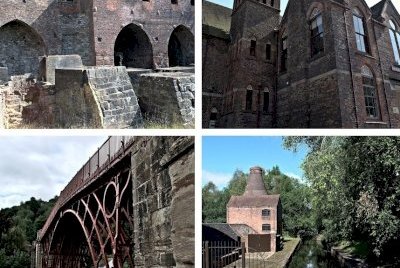
The Iron Bridge is an attractive if small structure over the River Severn, which was repainted in 2018 to what historians have determined was its original red colour. Set against the background of the picturesque town of Ironbridge, the bridge is not especially impressive until you remember it is now nearly 250 years old. References to this bridge are always careful to describe it as the first ‘major’ bridge to be made from cast iron as there was apparently an abandoned attempt to construct an iron bridge in Lyon in 1755 and a successful, but much smaller, decorative iron bridge in the grounds of Kirklees Hall, Yorkshire in 1769. However, Abraham Darby’s 1779 bridge here has rightfully become one of the iconic symbols of the Industrial Revolution. Even though many larger and/or more ornate bridges have since been constructed, this has the distinction of both being amongst the first and surviving to the present day.
Not too far out the town along the road to the east are the Bedlam furnaces, also free to access although with some signs of ageing, where iron ore was smelted to make the all-important metal. There are more furnaces at the Museum of Iron, which I did not get chance to visit, and at the Blists Hill Victorian Town. The Blists Hill furnaces are newer in construction, built between 1832 and 1844, but are more striking in their huge size and better preserved than the Bedlam furnaces. These furnaces and the remains of …
Keep reading 0 comments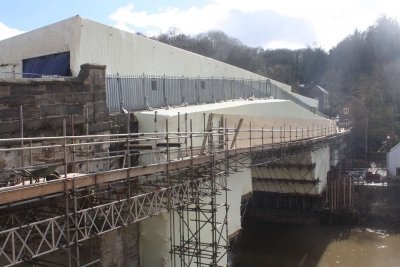
March 2018 - Oh no, we arrived in Ironbridge, but the main attraction was under renovation and wrapped in white sheets. What a pitty! Anyway we took a walk to both sides of the bridge and tried to get a glance of the historic sites of the gorge. We had pastries, fish and chips, and there was a nice shop with a tremendous selection of gin and beer.
Hay Brook Valley we did not want to visit, due to time constraints and due to the high prize. By car we drove further up the valley to see some more factories and finally left the WHS again.
I guess we could have seen more and reap more from the visit. But without the bridge the experience was anyway just moderate.
Keep reading 0 comments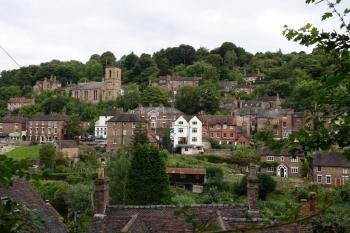
When I stepped off the bus in Ironbridge and got my first glimpse of the bridge I was already smitten. It’s a picturesque site, embedded in a lovely river valley with the usual English countryside charm. Little points to this having been a key site in UK’s industrial revolution.
Prior to the industrial revolution the iron ore was melted using charcoal. In my line of work we would call that biomass and consider it CO2 neutral, i.e. pretty great. But charcoal was tied to sustainable (then phew!) forestry and this severely limited the volume of ore you could melt. So you couldn’t actually leverage larger production sites. Only when the switch to coal and better yet coke occurred was real growth possible. The area around Ironbridge, already a center for iron production since medieval times, offered both iron and coal and grew rapidly as a consequence.
While this is yet another of UK’s industrial sites, I had a pleasant time and I think this is a valuable site. Due to this being on the forefront of industrialization the buildings seem to have fallen out of time compared to a later industrialization site such as Völklinger Hütte. But well, with the furnaces in operation and the chimneys blowing out huge smoke clouds day and night, the area probably looked far less idyllic.
Getting In and Around
From Monday to Saturday there are regular busses connecting Telford to Ironbridge. They do not run via the train station. …
Keep reading 0 comments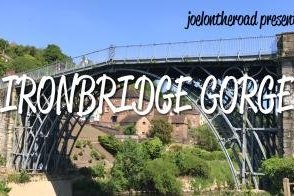
I visited this site with my wife in June 2017. We had a rental car and so were able to drive directly to the village itself. The bridge is quite impressive, though a bit smaller than I expected. Very beautifully constructed though, and the way the paths run around the gorge you can see it from most angles.
We also visited the New Bedlam blast furnaces but they were being restored and were fully fenced off. We also drove over to the museum but decided it was too expensive to fully explore. Here the large blast furnaces are in a separate building at the far end of the car park, so if it's quiet you might be able to sneak in and have a quick look. Not that we did that of course ;)
Overall it's an interesting site, but fairly typical of the UK Industrial Revolution sites. Not somewhere I'd particularly recommend going out of your way for, but a diversion to see the bridge is well worth it.
See below for my full video review!
Keep reading 0 comments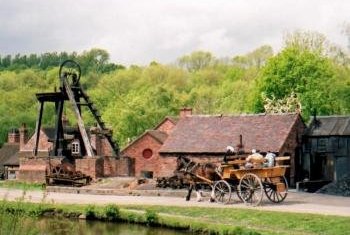
When I was planning a trip to Wales in 2005, I realized I would be traveling very close to Ironbridge Gorge, widely recognized as the birthplace of the Industrial Revolution. With my interest in world history, there was no way I could bypass this site, so I arranged for a day trip detour. The Severn River flows through the gorge, which is named for the famed Iron Bridge detailed in other reviews. I enjoyed walking over this remarkable piece of engineering, as well as viewing it from the trails on both banks of the river. Just as fascinating was the Blists Hill open-air museum, which included examples of the coal and iron mines involved in making this valley so important to the Industrial Revolution. In the early 18th century, Abraham Darby used coke, derived from coal, to fuel blast furnaces along the gorge. This created a less expensive source of cast iron and revolutionized the iron-making industry. Blast furnaces from the Madeley Wood Company are still on display at Blists Hill, and I was impressed by their conservation. Blists Hill also offers examples of a Victorian-era town, which I enjoyed exploring. I highly recommend this site for anyone with any interest in technological innovations in world history.
Logistics: An automobile is probably the easiest way to arrive at Ironbridge Gorge, as well as to navigate to the
multiple museums. There is also a train station at Telford, to the north of the gorge.
Keep reading 0 comments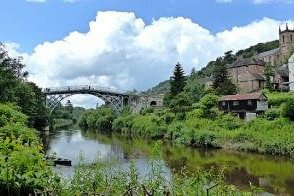
I visited this WHS in June 2016. Arriving from South Wales by car, I drove through several rural roads to get to Ironbrige. I parked at the pay and display car park next to the Ironbridge Gorge Museum (worth visiting) which is just a short walk away from the symbol of Industrial Revolution. Although there is a National Heritage sign just in front of the bridge, hidden just behind it in a corner with a dustbin strapped to the railings in front of it (not impressed at all!!!) was the official UNESCO plaque. Just a small trivia; apparently in 1987, the UK company in charge of producing the UNESCO plaques for the UK WH sites inscribed in 1986, made a mistake and all these signs have the same mistake "inscribed in 1987" or "1987" instead of 1986. In fact, the manager at Caernafon Castle in Wales (who told me about this!) removed the sign which is now hidden in the castle's multimedia room until new plaques arrive. Anyhow, apart from the several museums and a pleasant walk by the river just below the old tollhouse, there isn't much to entertain a longer visit. The village itself is very touristy and although I tried Eley's world famous hand raised pork pies (the small ones are more than enough!), I very much preferred Eley's hot pastries which I ate on the bench just opposite while enjoying the view. Considering the link with Blaenavon's industrial heritage for example, I think it would have …
Keep reading 0 comments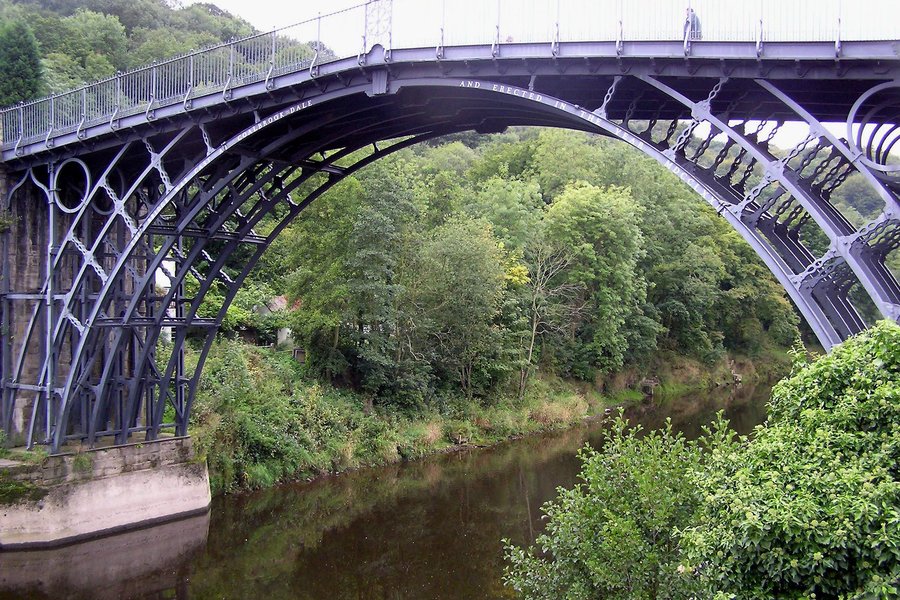
I visited Ironbridge with my grandparents in August 2013. Although there are something like 14 distinct things to see/museums in the vicinity, the eponymous Iron Bridge is the focal point. Whilst it isn’t particularly impressive when compared to modern bridges like Millau, at the time it was groundbreaking.
The bridge served two purposes: one, of course, was as a means of crossing the River Severn. This was an important thing for the town as it was at the epicentre of the early Industrial Revolution and was rapidly ramping up production of cast iron for export throughout the country and across the world. The second use of the bridge, however, was to serve as an audacious advert for the load-bearing properties of Shropshire steel. Anybody who didn’t believe the early claims of the steel barons had only to come to Ironbridge and see it himself.
Elsewhere in the vicinity of Ironbridge there are museums such as Blists Hill Victorian Town Be warned – the museums are not free like in Blaenavon. It costs £8.25 to get into the China museum, for example, and a pass to all the museums is £24!
The bridge is free, of course, and I satisfied myself by also visiting the Tar Tunnel (£3). This is a 3000 foot, 225 year old tunnel dug into the hillside by miners who struck natural bitumen. You can go about 50 metres into it, and see for yourself the tar oozing through the walls.
Keep reading 0 comments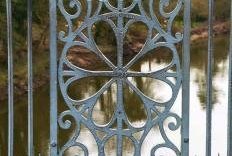
When my taxi driver pointed me to see the famous Ironbridge, the symbol of the Industrial Revolution, I felt quite underwhelmed with the appearance of the bridge which was very different from my imagination. The bridge was located in the middle of a very touristy village with many shops and restaurants that far from my ideal industrial valley. It seemed to me that apart from the modern power plant, the industry legacy of this valley was indeed a history.
After ate a piece of pork pie which claimed by owner to be the best in the world! It was time for me to see the bridge. I found that crossing the bridge was not quite a comfortable experience as the bridge was quite steep than normal pedestal bridge in the present time; however, the view of the village and gorge as well as the details of the bridge decorations were quite lovely. The number of 1779, the year that the bridge was erected was stamped in the middle of the bridge railings showing its historical significance. All in all, a fine place to visit for 15-20 minutes!
I decided not to visit any museum except the Ironbridge George Museum which had well stock of souvenirs. The friendly museum staff advised me how to go back to Telford where the nearest train station located. Two Korean tourists and I were very confused with two bus stops located in both side of the street in front of the bridge indicating …
Keep reading 0 comments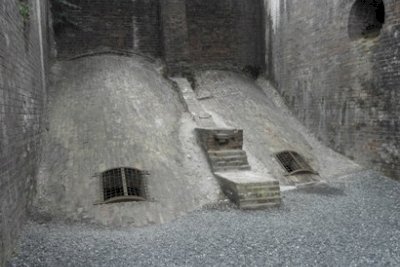
I visited the Ironbridge Gorge on a day trip from Llangollen, just over the border in Wales. My rental Ford Focus got me there via narrow, winding roads just before 10 a.m. I was early enough to get a parking spot in the center of Ironbridge town. I had printed out a hiking map beforehand (the South Telford Heritage Trail) and set out on foot to at least walk part of it.
The main focus at first is the Iron Bridge itself. It’s an imposing structure for its age, and pretty photogenic too. I crossed it and walked on the other side of the river Severn to Jackfield and Coalport. The walking trail here lies between the river and the main road, but the shrubs are too thick to see anything worthwhile. It is actually just the sort of path you see at BBC Crimewatch when someone is suddenly attacked by a stranger. Fortunately, nothing happened to me, I only encountered some fellow hikers.
The path ends near the former tile factories of Jackfield, and then I crossed the river again via the footbridge. This is where the Tar Tunnel lies, and also the Hay Inclined Plane (a lift or funicular for ships). Only the tracks remain. I walked back along the main road to Ironbridge.
After my walk, I tried two of the Ironbridge Gorge Museums. You can visit all 10 of them for a rather steep 22.5 pounds (they’re not exactly the Uffizi or the …
Keep reading 0 comments
I have the pleasure of both working for the Ironbridge Gorge Museums and being a local resident, so I hope that you can accept my short review!
Founded in 1967, the Ironbridge Gorge Museum Trust is a registered charity whose twin aims are education and heritage conservation.
The Trust cares for 36 scheduled monuments and listed buildings within the Ironbridge Gorge World Heritage Site and operates 10 museums which collectively tell the story of the birthplace of the Industrial Revolution. These museums received 567,000 visits in 2010, including around 70,000 school visits.
The largest of our sites is Blists Hill Victorian Town, which in 2009 saw the completion of a £12m development, supported by Advantage West Midlands and European Regional Development Funding. Following this generational investment, Blists Hill Victorian Town received 9 major regional and national awards including reaching the final of the Art Fund Prize for Museums & Galleries 2010, the largest arts prize in the United Kingdom.
As well as 10 museums, the sites in the Trust’s care include a research library, a tourist information centre, two youth hostels, archaeological monuments, historic woodlands, housing, two chapels, and two Quaker burial grounds.
In 2011 Ironbridge celebrated its 25th anniversary as one of the UK's first World Heritage Sites. We hope that many people take the opportunity to discover the many charms of this beautiful and historic site for themselves.
For more details visit www.ironbridge.org.uk
Keep reading 0 comments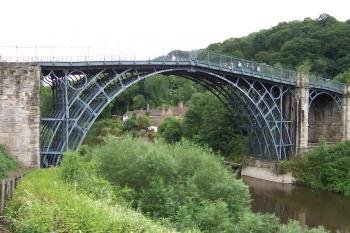
This was one of the original group of UK entries to the list, the site is essentially the birthplace of the Industrial Revolution. It was here that coke was first used on a large scale to produce iron, speeding up the process and making this town the industrial heart of the world for about a decade. The British list is quite heavy on Industrial heritage, and I think quite rightly so, as they are of massive global importance.
The town itself now is an idyllic little town, which is kept immaculately without being too sterile. The centre of the town is on one side of the river Severn, which is crossed by the Ironbridge (pictured) this was the first bridge to be made of this material in the world. It is an impressive piece of engineering and is a fantastic symbol for this period of history.
The site also includes neighbouring towns and their foundries, the most famous one is at Coalbrookedale and this is now a museum. The museum was nicely laid out, and if you want an introduction to the Iron making process then this is a great place to start. At the back of the forecourt are the remains of the first furnace to use coke, which I found to be a little more interesting than the museum itself.
Overall there are about 10 different museums in the area and you could easily spend a full day here going from one to the other. The distance to …
Keep reading 0 comments
